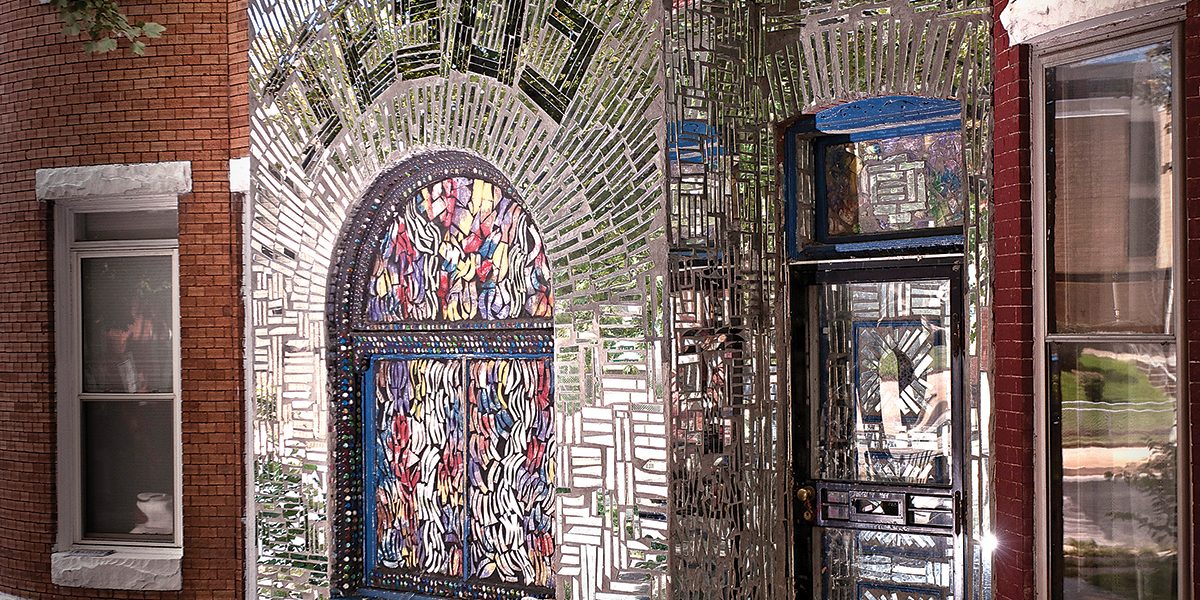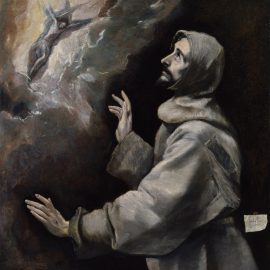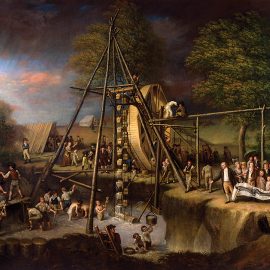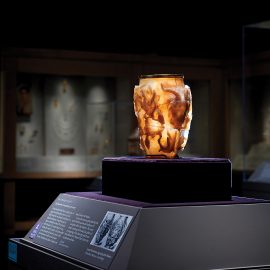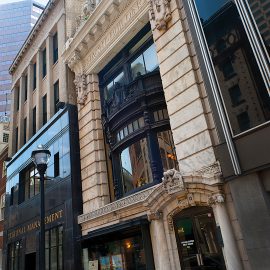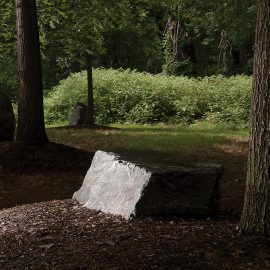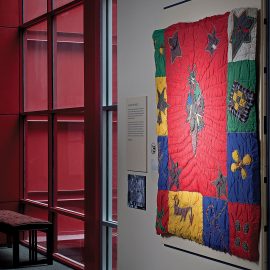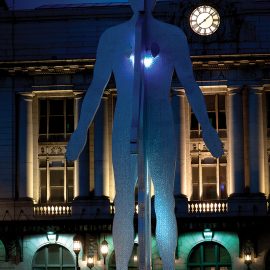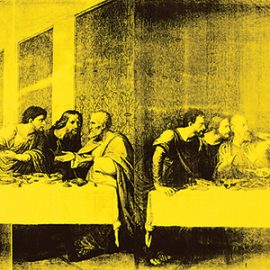Arts & Culture
Art All Around
Local artists and experts choose 37 artworks in Baltimore that you have to see, and their selections just might stir up debate about our perceptions of art and the city around us.
When we asked a group of art aficionados to identify must-see works
of art, we expected to hear about pieces in The BMA, The Walters, and
other museums and galleries around town. We got that, and a lot more.
Our respondents cited deserving masterpieces from Baltimore’s bastions
of high art, and they also made less obvious choices. You might expect
the Cone Collection would get mentioned—which it did—but a stretch of
Loch Raven Boulevard, or a SoWeBo barbershop? They made the cut, too,
and such inclusions suggest that the definition of art is increasingly
elastic. And why shouldn’t it be? A great city exhibits creative touches
and flourishes in unlikely and out-of-the-way spots, beyond its
established venues. Its creativity gets integrated into everyday life
all around us. You should see it.
Must-see art according to: Leslie King-Hammond
Director, Center for Race and Culture, Maryland Institute College of Art
Loring Cornish
Praise Houses
2700 Parkwood Avenue
This is
a must see for believers and non-believers. Loring Cornish is the
Master of Awe in his use of all things humble, ordinary, and mundane.
His artistry, technical facility, and awesome imagination help Baltimore
to understand the power of the extraordinary.
New Beginnings Barber Shop
Hollins and S. Arlington Streets
This is a most wonderful family experience in SoWeBo. The traditional
salon/barber shop concept has been transformed into an upscale
experience for having your body, mind, and spirit renewed. Troy Staton,
master barber and art collector, fills his space with exceptional works
of art, workshops for children, lectures, and exhibitions for local and
international artists.
Painted Screens of East Baltimore
Various locations in Canton, Fells Point, Little Italy, and Highlandtown
This is an opportunity to wander through East Baltimore and discover
the magicalpainted screens on Baltimore’s row houses. This is a
phenomenon unlike any other city in the United States and not to be
missed.
Must-see art according to: Maurice Berger
Research professor and chief curator at the Center for Art, Design and Visual Culture, University of Maryland, Baltimore County
Qing Dynasty Monochrome Ceramics
Hackerman House, The Walters Art Museum
Dozens of Qing Dynasty monochrome ceramics are situated on rows of
towering shelves in the ornate and painstakingly restored rooms of the
Hackerman House. Potted in China from the 17th through 19th centuries,
these vases, bowls, dishes, and scholar’s objects pay homage to the
austere, unadorned ceramics of the Song Dynasty, created more than 300
years earlier. In their simple, abstract form and brightly colored
glazes, they challenge you to rethink the origins and geography of
modernism.
Reginald F. Lewis Museum of Maryland African American History & Culture
830 E. Pratt Street
One of the city’s most compelling cultural experiences is contained not
within a work of art, per se, but an institution: the Reginald F. Lewis
Museum of African American History & Culture. What makes the museum
so engaging is its broad mandate, one that rigorously expands the
meaning of important visual culture to include artifacts as diverse as
paintings, sculptures, photos, posters, toys, magazines, books, and
films. The richness of the museum’s holdings and broad array of
temporary exhibitions—recent shows have explored the work of
contemporary black women artists, the life of baseball player Roberto
Clemente, and the significance of Baltimore’s Druid Hill Park for
generations of African Americans—make it a wonderful place for families
and young people.
Joseph Beuys Sculpture Park
UMBC campus
This is one of
Baltimore’s most contemplative and tranquil art experiences. Organized
by the Center for Art, Design and Visual Culture in 2000 and inspired by
Beuys, a renowned German conceptual artist who died in 1986, the public
park features a bucolic arrangement of 30 trees and boulders. The
installation, one of this city’s rare examples of large-scale “land
art,” is at once beautiful and thought provoking, a celebration of the
power of nature—and art—to inspire and heal, no less in the midst of a
bustling urban campus.
Must-see art according to: Jay Fisher
Deputy director for curatorial affairs and senior curator of prints, drawings, and photographs, The Baltimore Museum of Art
Hugo van der Goes
“Portrait of a Man at Prayer with Saint John the Baptist”
The Walters Art Museum
Hugo van der Goes is one of the first 15th-century Netherlandish
artists I ever learned about. When I saw his work, I was amazed by the
eloquent realism applied to his sensitive reading of the faces of people
in his religious scenes. It is rare to see his work in the United
States, and when I came to Baltimore to work at The BMA, I couldn’t
believe we had a wonderful example of his painting right here in the
city. There are so many little treasures in The Walters, but this is my
favorite.
Charles Willson Peale
“The Exhumation of the Mastodon”
Maryland Historical Society
“The Exhumation of the Mastodon” is such an important part of Baltimore
history. Peale was a great artist and the Peales established some of
the first art and archaeology museums in the U.S.—here in Baltimore and
in Philadelphia. I believe Peale exhibited the exhumed Mastodon skeleton
in his first museum in Philadelphia, but the Baltimore museum got
something that proved more lasting than the skeleton—Peale’s artistic
vision of the discovery and exhumation of this amazing creature. It
continues to enthrall museum visitors today. [This piece was also cited
by Doreen Bolger.]
Sir Anthony van Dyck
“Rinaldo and Armida”
The Baltimore Museum of Art
“Rinaldo and Armida” probably has more international renown than any
other painting at The BMA, maybe in Baltimore. It is one of the greatest
artworks ever made by this splendid painter. It is just a joy to look
at, full of movement, ravishing color . . . it looks like it belongs in a
palace, and, in fact, it used to belong to England’s King Charles—until
an enterprising Baltimore merchant felt strongly that the city would
benefit from having it here. It is the history and continuance of this
kind of cultural generosity that makes Baltimore a remarkable place to
live. [This piece was also cited by Joseph Sheppard.]
Must-see art according to: Gary Vikan
Director, The Walters Art Museum
Paul Gauguin
Woman of the Mango
The Baltimore Museum of Art
I hear music when I look at Paul Gauguin’s Woman of the Mango, painted
in 1892 while Gauguin was in Tahiti. (That’s his wife.) Paul Cézanne’s
Mont Sante-Victoire Seen from the Bibémus Quarry (also at The BMA and
also part of the famous Cone Collection) is magnificent as well, but
Gauguin’s work has a rare combination of startlingly powerful color and
profound mystery that adds up to very rare aesthetic poetry.
MICA’s Brown Center
1301 W. Mt. Royal Avenue
Named for
Baltimore philanthropists C. Sylvia and Eddie C. Brown, this
spectacularly translucent polyhedron was designed by Charles Brickbauer
with Ziger/Snead Architects. View it, if you can, from an elevated point
to the west, because this perspective offers a wonderful contrast
between the Brown Center and the elegant Renaissance revival Main
Building of MICA, from 1908, just across the street. Together, these two
buildings prove that great architecture is part of Baltimore’s present,
as well as its past.
“Rubens Vase”
The Walters Art Museum
There is not another work
to match it in any museum in the world. An astounding technical
achievement in carved agate, the “Rubens Vase,” from 4th-century
Constantinople, has a fantastic history of “close calls.” It was stolen
from the Imperial Palace of Constantinople by marauding Crusaders in
1204, then passed from one French royal collection to another, until
1592 when it was stolen again, from the royal château at Fontainebleau
by rioting Huguenots. This extraordinary (and very fragile) vase next
turned up in 1619 at a flea market in Paris, where the great Flemish
artist Peter Paul Rubens bought it for 20,000 gold florins. Rubens tried
to sell his vase to the Grand Mogul of India a few years later, but it
was lost in transit in a shipwreck off the coast of Australia. To hear
the end of this incredible story, stop by The Walters and check out our
audio tour.
Must-see art according to: Rebecca Hoffberger
Founder/director, American Visionary Art Museum
Tom Miller
“Children and Elders” mural
North Avenue and Harford Road
That piece just pops out at that intersection and really captures the
spirit and vitality of city life. I love the fact that you see the full
figures of the children, but you only see the adults from the knees
down.
Bob Hieronimus
“E Pluribus Unum” mural
Lexington Market
It’s his masterwork and includes all the symbolism that’s inspired him
for so long—from the founding fathers to Baltimore iconography.
Macht Building
11-13 E. Fayette Street
It’s one zaftig,
voluptuous building. That façade is one of the most amazing pieces of
architecture in Baltimore, and the female figures, done in marble, are
fantastic. The building is glorioso to women in the highest.
Must-see art according to: Joyce Scott
Artist
Druid Park Lake Drive
Starting at Madison Avenue and traveling toward 83
The park, the reservoir, the grand apartment buildings, and the distant urban forest are just like a mid-19th-century painting.
The Scene Outside My Front Door
Penn North neighborhood
I
lived in a challenged neighborhood, between Bolton and Reservoir Hills.
The braggadocio, this outside defense against life’s boredom and
oppression, is a passion play; the inhabitants are mobile dancers from
Lautrec; the drug dealers refer to Greco-Roman sculpture; and the
brightly colored babies and bling are über Pop art. This is super
surreality.
Elizabeth Caldwell Talford Scott
”Joyce’s Quilt”
Reginald F. Lewis Museum of Maryland African American History and Culture
My
mother died this year, and her image and quilt at the Reginald F. Lewis
Museum reminds me how the truth of art is from the soul.
Must-see art according to: Gary Kachadourian
Artist, winner of 2011 Baker Artist Award, former visual arts coordinator for Baltimore Office of Promotion & The Arts
Loch Raven Boulevard Linear Park
Loch Raven Boulevard between The Alameda and Hillen Road
Loch Raven Boulevard is part of what I understand to be an early
20th-century Olmsted Brothers plan for linear greenways connecting
Baltimore’s major parks. These also include Mt. Royal Avenue, 33rd
Street, Broadway, and a number of other streets. What makes this site
most compelling is how this idyllic construct interfaces with
contemporary life. The street has become purely a commuter road and the
greenway ends up seeming like any generic roadway divider (median strip)
while its rolling hills obstruct drivers’ views of buses making the
right-hand lane almost useless for cars. I especially love that it’s
always dotted with groupings of filled plastic lawn bags (community
efforts to groom the space?). This boulevard, along with the others from
this series of greenways, is part of one of the most conceptually
beautiful and ambitious hidden-in-plain-sight ideas enacted in
Baltimore.
“JOCE” graffiti mural
Seen from westbound I-95 as it passes over Monroe Street
I’ve always been a fan of the particular genre of graffiti that is
produced using house paint and rollers, and this is my favorite work
that is currently visible. It’s solitarily placed on the lower lefthand
corner of a large wall of an industrial building and is done in pink
block letters with brown outlines on a cream-colored wall, a formally
beautiful work with a Neapolitan ice-cream subtext.
“Wack-A-Moles” on former Current Gallery
30 S. Calvert Street
Current Gallery had to vacate its first space in 2009 when it was going
to be torn down for redevelopment of the block. For the final
exhibition at the space, Andrew Liang, one of the gallery’s
co-directors, painted the front and side of the building with
Wack-A-Moles, targets for the operator of the imminent wrecking ball.
Two years later the Wack-A-Moles are still waiting, an indicator that
time in the world of real-estate redevelopment follows a very different
metronomic path than the time most of us are used to. It should be noted
that the city gave this building—and now has given another building on
Howard Street—to Current rent-free, so this is a case of where urban
redevelopment’s slow movement has done great things for the arts.
Must-see art according to: Gerald Ross
Director of exhibitions, Maryland Institute College of Art
Wayne Kusy
“Lusitania”
American Visionary Art Museum
One
of America’s national treasures is the American Visionary Art Museum. In
it, is a “must-see” for anyone: the 16-foot-long replica of the
steamliner Lusitania built entirely out of toothpicks by artist Wayne
Kusy. Completed in 1994 and displayed in two halves (to get it out of
his apartment), Kusy took about two-and-a-half years to finish it,
working between two and three hours a night. The ship is complete with
portholes, smokestacks, stairs, and an elaborate inner structure—built
“anatomically” correct. It is an incredible monument to artistic as well
as historic perseverance, memory, and achievement.
Chamber of Wonders
The Walters Art Museum
The Walters Art
Museum (known to some, locally, as the “Mini Met”), is a great treasure
unto itself but within it, The Chamber of Wonders—a recreation of what a
southern Netherland nobleman might have assembled in the 17th
century—is another “essential” experience. Passing through a hall of
ancient armor, one enters an amazing space filled floor to ceiling with
extraordinary works of art, decorative objects, and furniture and
natural curiosities: collected butterflies, skulls, sea creatures, and
taxidermied animals (including an alligator!). This is truly a wonderful
and playful area to contemplate our world and the opportunities we have
to creatively interact with it.
Jonathan Borofsky
”Male/Female”
Penn Station
Jonathan
Borofsky is one of my favorite artists of the last 40-odd years. His
deliberate path is to create works and objects that attempt to examine
and portray the human condition and point to inner enlightenment and
positive change. His piece, “Male/Female,” installed in front of Penn
Station in 2004 has been called about every nasty thing in the book,
including “just plain ugly.” Sentimentality for its message aside, I
happen to see it as a true piece of “outsider art.” For me, it works on
many artistic levels but, ultimately, the piece’s distinctly alien
presence amid the history and depth surrounding it adds another layer to
the Baltimore that I love the best: the Baltimore that doesn’t quite
“fit in.”
Must-see art according to: Joseph Sheppard
Artist
Sir Anthony van Dyck
“Rinaldo and Armida”
The Baltimore Museum of Art
It made front-page headlines in The New York Times when it was
purchased. It is one of the world’s great paintings, certainly Van
Dyck’s most important work. It was painted to show off his skills in
landscape, still life, portrait, and figure painting to secure the
position of court painter in England. Few people are aware of it being
in the collection at The Baltimore Museum of Art.
Antoine-Louis Barye Collection
The Walters Art Museum
The
collection of Antoine Barye, the teacher of Rodin, is probably the most
extensive and best collection in the world of the foremost sculpture of
animalier in the 19th century.
Cone Collection
The Baltimore Museum of Art
The Claribel and
Etta Cone collection of early 20th-century avant-garde artists is the
most famous collection in Baltimore and includes Matisse, Picasso, Van
Gogh, Gauguin, and Cézanne.
Must-see art according to: Doreen Bolger
Director, The Baltimore Museum of Art
Gaia, “Raven”
Edgar Allan Poe House and Museum
Gaia’s “Raven”
can be seen at the Edgar Allan Poe House and Museum—or at other
locations around town where this fabled street artist has wheat-pasted
it to crumbling brick walls or fading billboards. This jaunty image was
inspired by Poe’s tragic poem about love lost. The story of its creation
is about the power of art to transform the urban environment: The
artist has donated 100 of his prints to be sold for the benefit of the
Poe House, which has lost its city funding. Get one while they last (I
did)!
Jean Baptiste Siméon Chardin
“The Game of Knucklebones”
The Baltimore Museum of Art
Chardin’s “The Game of Knucklebones,” on view in The BMA’s Jacobs Wing,
is an artwork I visit when I need to smile. A beautiful young woman is
playing knucklebones, sort of like jacks but with sheep bones, and she’s
just tossed a ball that’s suspended in the air. Dressed informally, she
looks as if she could be a scullery maid, but she’s probably an
upper-class woman. It’s obvious that she should be sewing (her needle is
stuck in her apron) and instead she’s fooling around. We all need an
artwork that reminds us to put aside work for a moment of fun or
pleasure!
Charles Willson Peale
”The Exhumation of the Mastodon”
Maryland Historical Society
The
Exhumation of the Mastodon was my favorite Baltimore work of art long
before I moved here. I first met this fascinating painting in a Peale
show at the Metropolitan Museum of Art, where it was featured in a 1983
exhibition that I worked on as a young curator. Peale, like his
contemporary Benjamin Franklin, epitomized the Age of Enlightenment. He
was a learned scientist, an inventor, a brilliant artist, and a showman.
Here, we see him holding a careful, accurate drawing of a bone from a
prehistoric creature later exhibited in his museum. Looking back from
2011, the breadth of Peale’s achievements set the tone for this city as a
center for art, science, and innovation.
Must-see art according to: Noah Charney
Bestselling author and art historian
Albrecht Dürer
“Melencolia I”
The Baltimore Museum of Art
Albrecht Dürer’s mysterious print, one of the greatest prints ever
made, is an unsolved mystery. No one knows its meaning, or what it
represents beyond an allegory of melancholy, featuring a brooding angel
surrounded by occult implements. Over the angel’s shoulder we can see a
“magic square,” a mathematical curiosity wherein the sum of any group of
four adjacent numbers is the same, in this case 34. Dürer chose this
version of the four-by-four magic square because at the bottom center
are the numbers 15 and 14: 1514 is the year he created the print.
Anonymous
16th-century copy of “Mona Lisa”
The Walters Art Museum
Leonardo’s “Mona Lisa” needs no introduction, but few know that there
are many excellent contemporary copies of Leonardo’s painting, some of
which may actually have been painted by Leonardo. It was not unusual for
Renaissance artists to make multiple copies of particularly renowned
works. The Walters has a fine copy of the “Mona Lisa.” A similar copy,
which hangs at the Louvre Museum outside the director’s office, was
boxed up during the Second World War, labeled as the original, and
shipped all over France, leading the Nazis on a wild goose chase. The
Nazis thought they had stolen the original “Mona Lisa” when, in fact,
they had been chasing after this copy, while the original never left
Paris.
Jusepe de Ribera
“Saint Paul the Hermit”
The Walters Art Museum
Ribera is a candidate for the greatest artist whom no one has heard of.
Aside from art historians specializing in 17th-century Baroque
painting, the great Spanish painter Ribera has slipped beneath the
radar. He was the best among the Caravaggisti, artists emulating the
revolutionary drama, chiaroscuro, and realism of Caravaggio. But while
others imitated Caravaggio, Ribera took his style and made of it
something new and wonderful. Noboby, not even Caravaggio, paints the
aged male form better than Ribera.
Must-see art according to: Raoul Middleman
Artist
Rembrandt
“Portrait of Titus”
The Baltimore Museum of Art
In this painting, Titus has two thumbs on the hand propping up his
chin, denoting his restless shifts during the pose. The painting is all
about father-son relationships.
Paolo Veronese
“Portrait of Countess Livia da Porto Thiene and her Daughter Porzia”
The Walters Art Museum
In the Walters, there is a spectacular painting of a mother-daughter
combo by Veronese that complements the Rembrandt with a Venitian versus a
Dutch perspective.
El Greco
”Saint Francis Receiving the Stigmata”
The Walters Art Museum
Also
in the Walters is a singular El Greco; a Saint rendered with almost
total monochromatic grays, but it has the sensation of full color.
Must-see art according to: John Waters
Artist, Writer, Filmmaker
Andy Warhol
”The Last Supper”
The Baltimore Museum of Art
Whenever
I am feeling really good about living in Baltimore I go by The BMA and
hope to see that amazing puke-green “Last Supper” by Warhol. Then,
feeling even better, I head toward the Visionary Art Museum and pay a
visit to Andrew Logan’s giant Divine statue and hope one day this will
be done in bronze and placed right next to Frank Zappa’s in
Highlandtown. Or better yet, out front of the train station—even though
“Male/Female” by Jonathan Borofsky is perfectly fine there.
